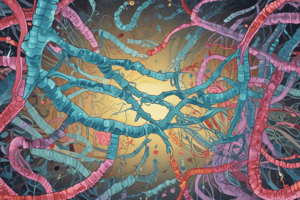Podcast
Questions and Answers
What is the naming convention for prokaryotic gene names?
What is the naming convention for prokaryotic gene names?
How do prokaryotes primarily reproduce?
How do prokaryotes primarily reproduce?
What is the mechanism of genetic exchange involving a virus in prokaryotes?
What is the mechanism of genetic exchange involving a virus in prokaryotes?
How do prokaryotes adapt and evolve despite not reproducing sexually?
How do prokaryotes adapt and evolve despite not reproducing sexually?
Signup and view all the answers
Which type of mutation is shown using the delta symbol?
Which type of mutation is shown using the delta symbol?
Signup and view all the answers
What do genomic loci encode in E. coli that are involved in maltose fermentation?
What do genomic loci encode in E. coli that are involved in maltose fermentation?
Signup and view all the answers
In classic bacterial genetics, how are mutations named?
In classic bacterial genetics, how are mutations named?
Signup and view all the answers
What type of mutations can result in DNA being added or lost, leading to frameshift mutations?
What type of mutations can result in DNA being added or lost, leading to frameshift mutations?
Signup and view all the answers
What is the process called when a prophage is induced and its DNA is excised from the genome & packaged into phage particles, sometimes including neighboring DNA by mistake?
What is the process called when a prophage is induced and its DNA is excised from the genome & packaged into phage particles, sometimes including neighboring DNA by mistake?
Signup and view all the answers
What type of plasmid is typically involved in mediating conjugation, requiring cell-cell contact?
What type of plasmid is typically involved in mediating conjugation, requiring cell-cell contact?
Signup and view all the answers
What is the name of the model plasmid originally identified in E. coli which is involved in conjugation?
What is the name of the model plasmid originally identified in E. coli which is involved in conjugation?
Signup and view all the answers
What type of cells are strains with an F plasmid known as?
What type of cells are strains with an F plasmid known as?
Signup and view all the answers
What do some tra genes encode that are produced by F+ cells and attach to F- cells only?
What do some tra genes encode that are produced by F+ cells and attach to F- cells only?
Signup and view all the answers
What happens after the pilus attaches and brings two cells together during conjugative transfer of F plasmids?
What happens after the pilus attaches and brings two cells together during conjugative transfer of F plasmids?
Signup and view all the answers
What does an Hfr cell stand for in the context of conjugative transfer?
What does an Hfr cell stand for in the context of conjugative transfer?
Signup and view all the answers
What can be transferred to recipient strain's genome via Hfr cell conjugative transfer?
What can be transferred to recipient strain's genome via Hfr cell conjugative transfer?
Signup and view all the answers
What will ultimately be lost if acquired DNA is not evolutionarily useful?
What will ultimately be lost if acquired DNA is not evolutionarily useful?
Signup and view all the answers
How can microbial genomes contain horizontally-acquired DNA?
How can microbial genomes contain horizontally-acquired DNA?
Signup and view all the answers
What are some impacts of horizontal gene transfer in microbiology?
What are some impacts of horizontal gene transfer in microbiology?
Signup and view all the answers
What is the natural mutation rate for prokaryotes per 1000 base pairs per round of replication?
What is the natural mutation rate for prokaryotes per 1000 base pairs per round of replication?
Signup and view all the answers
Which enzyme is commonly used to identify colonies with altered gene expression in bacteria?
Which enzyme is commonly used to identify colonies with altered gene expression in bacteria?
Signup and view all the answers
How can foreign DNA enter a prokaryotic cell?
How can foreign DNA enter a prokaryotic cell?
Signup and view all the answers
What plays an important role in the integration of foreign DNA into the host genome?
What plays an important role in the integration of foreign DNA into the host genome?
Signup and view all the answers
What are transposable elements?
What are transposable elements?
Signup and view all the answers
How do many transposable elements move from one place to another?
How do many transposable elements move from one place to another?
Signup and view all the answers
Study Notes
Bacterial Genetics and Gene Transfer
- Screening for mutants with a desired phenotype can be achieved by detecting single colonies that produce a detectable signal, such as color or fluorescence.
- The enzyme β-galactosidase is commonly used to identify colonies with altered gene expression in bacteria.
- The natural mutation rate for prokaryotes is approximately 10^-6 – 10^-7 per 1000 base pairs per round of replication.
- Acquiring mutations plays a major role in prokaryotic evolution, and horizontal gene transfer from foreign DNA plays an even bigger role.
- Foreign DNA can enter a prokaryotic cell through transformation, transduction, or conjugation, and once inside, it can be degraded, replicated as a separate entity, or integrated into the chromosome.
- Genetic recombination, specifically homologous recombination, plays an important role in the integration of foreign DNA into the host genome.
- Foreign DNA with homology to a region of the host chromosome can be inserted into the genome, replacing or duplicating native DNA sequences.
- Transposable elements, containing a transposase gene flanked by inverted repeats, are mobile genetic elements that can cause DNA rearrangements and insertions.
- Many transposable elements use conservative (cut and paste) mechanisms to move from one place to another, while others use a replicative mechanism to produce and insert a copy elsewhere.
- Transformation is the process by which free DNA is incorporated into a recipient cell, often through the capture of DNA by pili in competent organisms.
- Bacteriophages are viruses that infect bacteria and can operate through lytic or lysogenic pathways, integrating their DNA into the host DNA as a prophage.
- Transduction is a process in which a virus (phage) transfers DNA from one cell to another, contributing to gene transfer in bacteria.
Studying That Suits You
Use AI to generate personalized quizzes and flashcards to suit your learning preferences.
Related Documents
Description
Test your knowledge on bacterial genetics and gene transfer mechanisms, including mutation, horizontal gene transfer, genetic recombination, transposable elements, transformation, bacteriophages, and transduction. Explore how bacteria acquire genetic variation and exchange genetic material through different processes.




